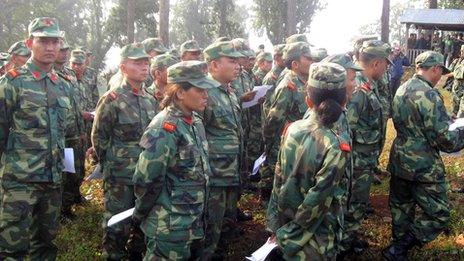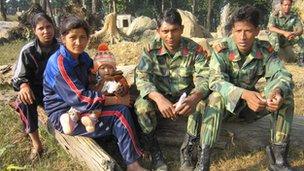Why do Nepal's former rebels want to join the army?
- Published

The reintegration issue is central to Nepal's ongoing political stability
When Nepal's ruling Maoist party signed a landmark deal in November allowing former guerrillas to retire, retrain in a new career, or become part of the Nepali army, few predicted that the majority would opt to join their old enemies in the military.
The process of regrouping almost 19,000 former rebels is now drawing to a close and political parties say they have been stunned by the number of Maoist fighters who have opted for the army.
The take-up rate has been so high that it could even derail their plans to integrate up to 6,500 former rebels into a proposed new wing of the army.
But opposition parties say that a new constitution for Nepal - a vital part of the peace process - cannot be drafted until the process of regrouping all registered former rebels has been completed.
Talks between Nepali political parties have been bitter and hard fought and one of the main sticking points in the peace process was precisely the fate of these former fighters. Analysts say they may now be faced with an unpredictable situation.
By Monday, government monitors had interviewed around 16,000 rebels. At the last count, more than half had opted for the army while most of the others went for voluntary retirement.
The option for "rehabilitation", which is the option strongly supported by Nepal's opposition parties and is also worth up to 900,000 rupees ($11,000/£7,000), has largely been spurned.
That option aims to wean former rebels away from the Maoist party fold by providing them with cash incentives and training on income-generating schemes. But only a handful have chosen it, officials say.
'Rebel' army wing
As things stand, it appears that the original plan that the new wing of the army should number around 18,500 troops - former Maoists comprising 35% of the total - will have to be revised.

Many former rebels are eager to join the army in defiance of some of their leaders
"If there are more of our comrades who opt to join the army, then the political parties might need to review their earlier agreement. They may need to show some flexibility on numbers," said Nanda Kishore Pun, chief of the Maoist's rebel army.
Mr Pun spoke about the possibility of enlarging the proposed army wing to number 25,000 to accommodate the former rebels.
But that idea is met with caution by the opposition parties.
"Let's not speculate about anything other than the signed agreement. If we start talking about flexibility then that could complicate the whole process of integration," said Minendra Rijal, a leader of opposition Nepali Congress (NC) and a member of special committee formed to manage the process of integration and rehabilitation.
Another opposition party, the Communist Party of Nepal-Unified Marxist Leninist (CPN-UML), is equally adamant that no more than 6,500 Maoists should be able to join the army.
In fact, it has been the numbers issue that has for so long delayed the process of integrating the former rebels. The issue was settled, in principle, earlier this month when the Maoists and the opposition parties agreed to the three options.
The former insurgents have been living in designated camps across the country since the cessation of conflict five years ago.

Many fear dark days ahead for Nepal if a final peace cannot be secured
Non-combat role
"Our background is military in nature. We always wanted to work for the sake of the country by joining the national army," said Sunita Gautam, a former female guerrilla who is one of those now wanting to join the army.
Exactly why she and so many of her comrades are so keen to sign up is a mystery given that most former fighters will not get senior positions in the army and where their mandate is limited to a strictly non-combat role.
The agreement states that former Maoists will become forest guards, disaster management personnel and security forces at industrial units.
According to the agreement, fighters chosen for integration into the army will need to go through a bridging course and further recruitment tests before they can be formally enlisted.
Those former fighters who have opted for voluntary retirement receive a lump sum before abandoning their uniforms.
Shrawan Kumar Rayamajhi, who had fought for six years as a Maoist guerrilla before the peace process, says he feels battle fatigued and wants to retire.
"I have had enough of fighting. Though I am not very happy with the packages offered, and though we have not been able to completely fulfil the desires of the people for which we fought, at least the phase of indecision has ended with this agreement," he said.
Another fighter, Kopila Shrestha, has a different reason for choosing voluntary retirement. "I have a small kid to look after so I could not choose to join the army," she said.
'Disrespectful' to join
The flood of fighters wanting to join the army, however, demonstrates the weak hold the hard-liners within the Maoist party have on their followers.
Maoist Vice Chairman Mohan Baidya strongly urged former combatants to stay out of the army, arguing that it would be "disrespectful".
Mr Baidya's faction of the party argues that the Maoist insurrection has not yet achieved its objectives.
The Maoists launched their "people's war" in 1996. More than 13,000 lives were lost in the decade before the insurgency finally ended in 2006.
And while the future of former fighters remains unclear - the process of writing a new constitution also hangs in the balance.
The integration issue remains central to Nepal's peaceful and turbulence-free future.